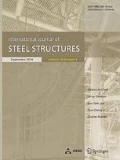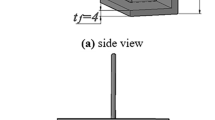Abstract
Composite structures are used in structural systems to take advantage of concrete and steel, and the role of shear connectors between the two is extremely important. Currently, anchor- and angle-type connectors are mainly used as shear connectors, and the angle type offers several advantages over the anchor type. The angle type can be manufactured as a shape that fits the composite structure with a greater basic strength than that of the anchor type, so it can be installed in wider spaces. Much research has been conducted on the anchor type, but that on the angle type has been insufficient so far. In this study, push-out and yield-strength tests were conducted on various angle-type shear connectors used for filling-type composite beams. The variables included the height, width, and thickness of the angle-type shear connector. The tests were terminated when a strength reduction of 80% of the maximum strength occurred. The slip capacity of the specimen was evaluated by referring to Eurocode. Based on the experimental results, the design equations have been reviewed to determine whether or not they can be used for the shear connection of concrete-filled composite beams. In addition, the strength was assessed by existing design equations. Meanwhile, a new design equation was proposed, including the height of the shear connector, which is not considered in the current design equations. The other strength was calculated by the new design equation.












Similar content being viewed by others
References
AISC. (2016). Specification for structural steel buildings (AISC 360-16). Chicago: American Institute of Steel Construction.
Androutsos, C. (1994). Composite beams with headed studs in narrow ribbed metal deck. M.Sc. thesis, University of Saskatchewan, Canada.
Balasubramanian, R., & Rajaram, B. (2016). Study on behaviour of angle shear connector in steel-concrete composite structures. International Journal of Steel Structures, 16(3), 807–811.
CAN/CSA-S16-01. (2001). Limit states design of steel structures. Ontario, Canada: Canadian Standard Association Toronto.
CEN. (2001). prEN 1994-1-1:2001: Draft No.2 of Eurocode4, design of composite steel and concrete structures part 1.1: General rules and rules for buildings. Brussels, Belgium: Committee European de Normalisation (CEN).
CEN. (2004). EN 1994-1-1: Eurocode4: Design of composite steel and concrete structures part 1-1: General rules and rules for buildings. Brussels, Belgium: European Committee for Standardization (CEN).
KSA. (2017a). Standard test method for compressive strength of concrete (KS F 2405). Seoul: Korea Standards Association.
KSA. (2017b). Test pieces for tensile test for metallic materials (KS B 0801). Seoul: Korea Standards Association.
KSA. (2018). Method of tensile test for metallic materials (KS B 0802). Seoul: Korea Standards Association.
Lee, J.-S., Shin, K. J., Lee, H. D., & Kim, S. Y. (2019). Flexural strength of filled composite beams with embossing webs. Journal of Korean Society of Steel Construction, 31(3), 189–197.
Lee, M.-K., Shin, K. J., Lee, J. S., & Chae, I. S. (2019). Push-out test on evaluation of shear strength using angle shear connectors. Journal of Korean Society of Steel Construction, 31(6), 413–421.
Mazozl, A., Benanane, A., & Titoum, M. (2013). Push-out tests on a new shear connector of I-shape. International Journal of Steel Structures, 13(3), 519–528.
Pashan, A. (2006). Behavior of channel shear connectors: Push-out tests. M.S. thesis, University of Saskatchewan, Canada.
Shariati, M., Ramli Sulong, N. H., Arabnejad Khanouki, M. M., & Mahoutian, M. (2013). Shear resistance of channel shear connectors in plain, reinforced and lightweight concrete. Scientific Research and Essays, 6(4), 977–983.
Shariati, M., Ramli Sulong, N. H., Shariati, A., Arabnejad, M. M. K., & Sinaei, H. (2012). Behaviour of C-shaped angle shear connectors under monotonic and fully reversed cyclic loading: An experimental study. Materials and Design, 41, 67–73.
Titoum, M., Mazoz, A., Benanane, A., & Ouinas, D. (2016). Experimental study and finite element modelling of push-out tests on a new shear connector of I-Shape. Advanced Steel Construction, 12(4), 487–506.
Wu, H. (1998). Headed stud shear connectors in full-size composite beams with wide ribbed metal deck. M.Sc. thesis, University of Saskatchewan, Canada.
Author information
Authors and Affiliations
Corresponding author
Additional information
Publisher's Note
Springer Nature remains neutral with regard to jurisdictional claims in published maps and institutional affiliations.
Rights and permissions
About this article
Cite this article
Lee, JS., Shin, KJ., Lee, HD. et al. Strength Evaluation of Angle Type Shear Connectors in Composite Beams. Int J Steel Struct 20, 2068–2075 (2020). https://doi.org/10.1007/s13296-020-00433-2
Received:
Accepted:
Published:
Issue Date:
DOI: https://doi.org/10.1007/s13296-020-00433-2




